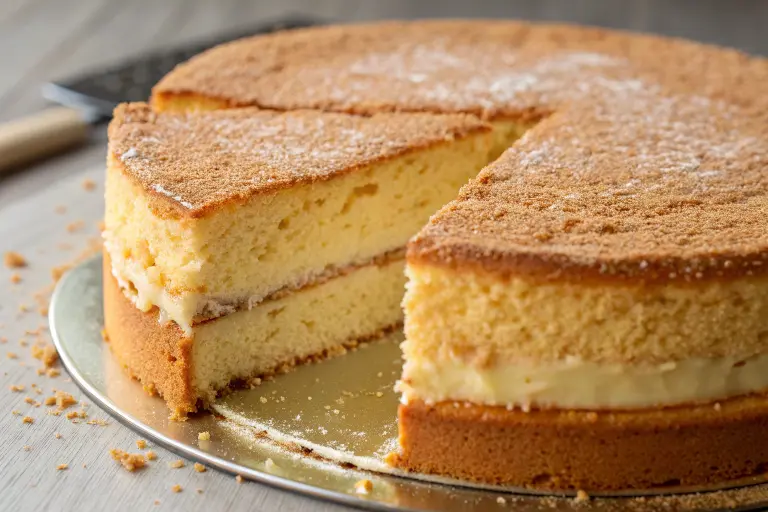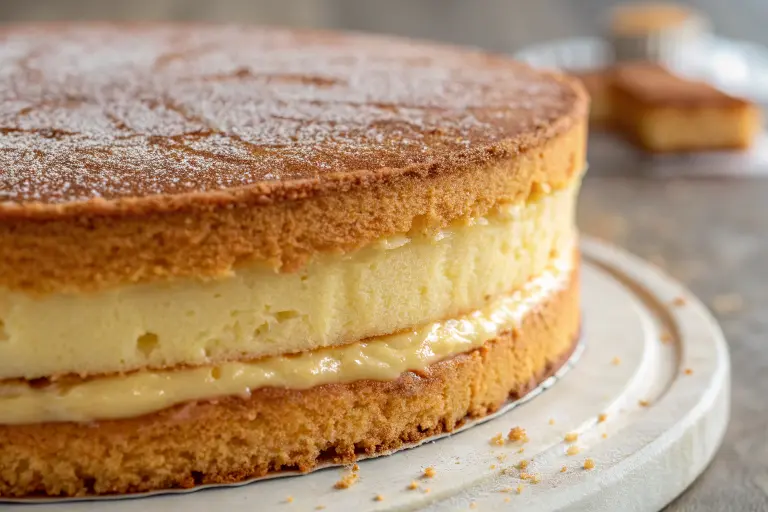The Joconde sponge is more than just a cake, it’s a culinary masterpiece that combines history, artistry, and technique in every bite. This light, almond-based sponge cake has captivated the attention of professional bakers and dessert enthusiasts alike. But what exactly makes the Joconde sponge so special, and why is it called Joconde sponge? The answer lies in its fascinating history, unique texture, and its connection to one of the world’s most iconic works of art.
In this guide, we’ll dig in deeply into the origins of the Joconde sponge, explore its distinctive characteristics, and uncover why this elegant cake continues to be a favorite in both classic and contemporary desserts. Whether you’re an aspiring pastry chef or a home baker looking to add a touch of sophistication to your creations, understanding the true essence of the Joconde sponge is key to mastering its use in stunning desserts.
What Is Joconde Sponge?
The Joconde sponge is a versatile and sophisticated cake that stands apart from traditional sponge cakes due to its use of almond flour, eggs, and sugar. This almond-based sponge is known for its light, airy texture, yet it retains a subtle density that enhances its structural integrity. The incorporation of almond meal not only imparts a distinct nutty flavor but also lends the Joconde sponge its characteristic moistness and flexibility. These qualities make it an indispensable component in the creation of delicate and intricate desserts.
Unlike traditional sponges, which can be somewhat fragile, the Joconde sponge excels in providing both stability and adaptability. Its texture allows it to be molded into various shapes, making it ideal for desserts that require precise structural support. Its durability ensures that it holds up well in layered cakes, such as opera cakes and entremets, where multiple layers of mousse or cream need a solid base that won’t collapse under pressure.
Characteristics of Joconde Sponge
- Flavor: The Joconde sponge boasts a subtle, nutty flavor due to the almond flour. This gives it a rich, slightly sweet profile that pairs beautifully with a wide variety of fillings and toppings. The almond flour not only enhances the flavor but also adds depth, distinguishing the Joconde sponge from regular sponges, which often have a more neutral taste.
- Texture: One of the standout features of the Joconde sponge is its flexibility. This sponge has a slightly denser yet incredibly moist texture, which allows it to be rolled or shaped without cracking. This pliability is essential for creating visually appealing desserts, especially those that require intricate or curved layers, like the famous opera cake or entremet-style cakes. The Joconde sponge can be thinly sliced into delicate layers, which hold their shape even when stacked or manipulated into complex designs.
- Appearance: Aesthetically, the Joconde sponge is often baked in thin layers, which can be decorated with a variety of patterns. Its ability to hold intricate designs, such as those made using printed patterns or decorative pastes, elevates the visual impact of the desserts it forms the base of. The light golden color and smooth surface of the Joconde sponge make it not only a delicious base but a stunning canvas for artistic creations.
The Joconde sponge’s unique characteristics, flavor, texture, and visual appeal, set it apart from other types of sponge cakes. Its versatility and ability to maintain structure while remaining light make it a prized ingredient in professional patisseries. Whether used in layered cakes, tarts, or as a canvas for decorative designs, the Joconde sponge plays a pivotal role in some of the most refined and celebrated desserts in both classic and modern pastry.
Why Is It Called Joconde Sponge?
Historical Background
The name Joconde sponge draws its inspiration from “La Joconde,” the French name for the renowned Mona Lisa painting by Leonardo da Vinci. Just as the Mona Lisa embodies elegance and artistry, so too does the Joconde sponge reflect these qualities in the realm of pastry.
The term “Joconde” pays homage to the artistic finesse required in creating desserts using this sponge. Much like the intricate brushstrokes that define the Mona Lisa, the Joconde sponge allows pastry chefs to craft desserts with detailed patterns and designs. This artistic parallel underscores not only the technical skill involved in pastry artistry but also the aesthetic beauty that can be achieved through culinary creations.
Cultural Significance
Beyond its artistic connotations, the term “Joconde” also holds cultural significance within French culinary traditions. In France, naming dishes after cultural icons or works of art is a common practice that emphasizes the intersection of culinary and visual art. By naming this sponge after “La Joconde,” French pastry chefs celebrate both the historical legacy of Leonardo da Vinci’s masterpiece and the enduring influence of artistic expression in gastronomy.
The use of the term “Joconde sponge” thus serves as a nod to the rich cultural tapestry of French cuisine, where aesthetics play a pivotal role in both the presentation and appreciation of food. This cultural significance highlights the Joconde sponge as more than just a cake, it is a symbol of culinary artistry and creativity, where each creation pays tribute to both the palate and the eye.

How to Make Joconde Sponge
Creating a Joconde sponge at home may seem daunting, but it is achievable with the right ingredients and techniques. Follow these steps to craft this exceptional sponge.
Ingredients
- 100g almond flour
- 100g powdered sugar
- 3 large eggs
- 3 large egg whites
- 30g granulated sugar
- 30g all-purpose flour
- 20g melted butter (cooled)
Instructions
- Prepare the Batter:
- Whisk almond flour, powdered sugar, and whole eggs until light and fluffy.
- Gently fold in the sifted flour.
- Whip the Egg Whites:
- In a separate bowl, whip egg whites with granulated sugar to stiff peaks.
- Fold the meringue into the almond mixture in stages.
- Add Butter:
- Carefully mix in the melted butter to maintain the batter’s lightness.
- Bake:
- Spread the batter evenly onto a parchment-lined baking sheet.
- Bake at 220°C (425°F) for 5-7 minutes or until golden.
This method make a perfect balance of texture and flavor, preserving the Joconde sponge’s signature characteristics.
Applications of Joconde Sponge in Modern Desserts
The versatility of the Joconde sponge extends beyond its flavor. Its ability to hold intricate designs and provide structural support makes it ideal for a range of desserts.
Opera Cake
The Joconde sponge serves as the foundation for the opera cake, a classic French dessert. Its thin layers are interspersed with coffee buttercream and ganache, creating a harmonious blend of flavors.
Entremets
Entremets are multi-layered mousse cakes often encased in a patterned Joconde sponge. These cakes showcase the sponge’s flexibility and aesthetic appeal.
Decorative Patterns
One of the unique features of the Joconde sponge is its ability to hold printed patterns. By spreading a decorative paste on a baking mat before adding the batter, bakers can create intricate designs that elevate the presentation of desserts.
Tips for Perfecting Joconde Sponge
Creating the perfect Joconde sponge requires attention to detail and a solid understanding of the techniques involved. Even experienced bakers may encounter challenges when making this delicate almond-based cake. To help you master it, here are some comprehensive tips to ensure your Joconde sponge turns out flawless every time:
1. Use Fresh Ingredients
The foundation of any excellent Joconde sponge lies in the quality of its ingredients.
- Almond Flour: Opt for finely ground, fresh almond flour with no added preservatives or oils. Fresh almond flour contributes to the nutty flavor and smooth texture that define a good Joconde sponge.
- Eggs: Use room-temperature eggs to achieve optimal volume when whipping. Cold eggs don’t whip as well, which can affect the sponge’s lightness.
2. Master the Mixing Technique
Proper mixing is critical to maintaining the light and airy structure of the Joconde sponge.
- Whisk Thoroughly: Begin by whisking the almond flour, powdered sugar, and whole eggs until the mixture becomes pale, thick, and fluffy. This aeration is crucial for the sponge’s soft texture.
- Fold Gently: When incorporating the whipped egg whites, fold them into the almond mixture in small batches to avoid deflating the batter. Overmixing can result in a dense sponge.
3. Spread Batter Thinly and Evenly
The Joconde sponge is traditionally baked in thin, even layers to achieve its signature flexibility and aesthetic appeal.
- Use a Spatula: Spread the batter evenly across a parchment-lined or silicone baking mat using an offset spatula. This ensures consistent thickness, which is important for even baking.
- Check for Evenness: Before baking, inspect the surface to ensure there are no lumps or uneven spots that could lead to irregular textures.
4. Monitor Baking Time and Temperature
Baking the Joconde sponge correctly is key to achieving its moist, pliable texture.
- Preheat Properly: Ensure your oven is fully preheated to 220°C (425°F) for consistent heat distribution.
- Keep It Short: The sponge bakes quickly, typically in 5–7 minutes. Overbaking can dry it out, making it brittle and prone to cracking.
- Visual Cues: Watch for a light golden color as an indicator that the sponge is ready. Avoid relying solely on the timer, as ovens can vary.
5. Handle with Care After Baking
Once baked, the Joconde sponge requires gentle handling to maintain its structure.
- Cool on the Pan: Allow the sponge to cool slightly in the pan before attempting to move it. This prevents tearing or breaking.
- Use Parchment Paper: If layering or rolling the sponge, use parchment paper to support it during handling and assembly.
6. Pay Attention to Presentation
For decorative designs, prepare a patterned paste to create intricate prints on your Joconde sponge before adding the main batter. This step elevates the sponge’s aesthetic appeal and adds a professional touch to your desserts.
7. Practice Patience
The Joconde sponge requires precision and care at every step. Don’t rush the process, as haste can lead to deflated batter, uneven baking, or cracks. Take your time to ensure each stage is executed properly.
By following these tips, you can consistently achieve a light, moist, and visually stunning Joconde sponge that’s perfect for creating elegant desserts like opera cakes, entremets, and patterned rolls. Mastering this versatile sponge will elevate your baking skills and open up a world of possibilities in French patisserie.
Why Does the Joconde Sponge Stand Out?
Nutritional Benefits
While primarily a dessert component, the Joconde sponge contains almond flour, which provides healthy fats, fiber, and protein. This makes it a slightly more nutritious choice compared to traditional sponge cakes.
Aesthetic Appeal
The sponge’s ability to incorporate patterns and hold its shape enhances the visual appeal of desserts. This makes it a favorite among pastry chefs who prioritize presentation.

FAQs: Why is it called Joconde sponge?
❓ What Is the Difference Between Joconde Sponge and Regular Sponge Cake?
The primary difference lies in the use of almond flour in the Joconde sponge, which adds a nutty flavor and flexibility. Regular sponge cakes rely on wheat flour and are less pliable.
❓ Can Joconde Sponge Be Made Gluten-Free?
Yes, substituting all-purpose flour with a gluten-free blend can make the Joconde sponge suitable for those with gluten sensitivities.
❓ Why Is It Called Joconde Sponge and Not Almond Sponge?
While almond flour is a key ingredient, the name Joconde reflects the artistic and cultural significance associated with the cake, tying it to the elegance of the Mona Lisa.
Conclusion: Why is it called Joconde sponge?
The Joconde sponge is a remarkable representation of the artistry and ingenuity that define French patisserie. This almond-based sponge cake is celebrated for its light texture, nutty flavor, and exceptional versatility, making it a cornerstone of many exquisite desserts. Its cultural and historical ties to the iconic Mona Lisa add depth to its story, enhancing our appreciation for this culinary masterpiece. Understanding why it is called Joconde sponge not only enriches your knowledge but also connects you to the rich traditions of French baking.
Whether you’re a seasoned pastry chef or an aspiring home baker, mastering the Joconde sponge is a gateway to creating desserts that are both visually captivating and delicious. Its adaptability allows you to craft elegant layered cakes, intricate entremets, and decorative patterned sponges that showcase your creativity and skill.
Looking for more recipe inspiration? Explore our blog for delightful options like Dark Chocolate Peanut Butter Cups to satisfy your chocolate cravings or a classic Pumpkin Cheesecake that’s perfect for any occasion. These recipes, alongside your newfound expertise in the Joconde sponge, are sure to elevate your dessert game.
And don’t miss out on more great ideas for healthier baking and cooking. For additional tips, recipes, and updates, follow us on Chaynez Recipes to access our latest posts and social media links.






